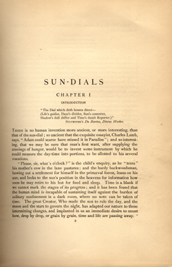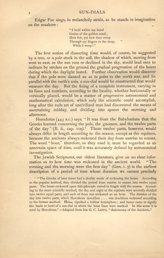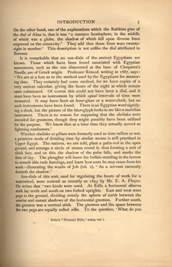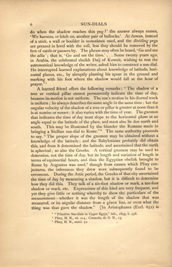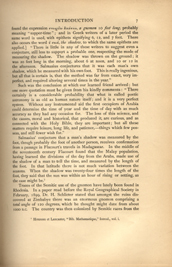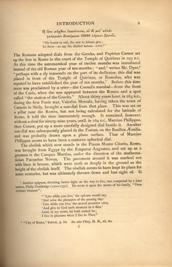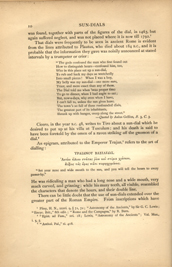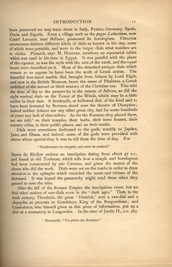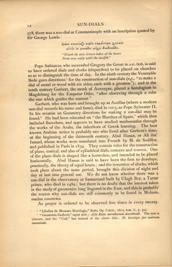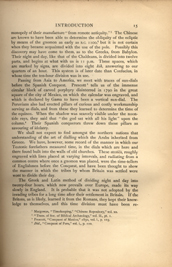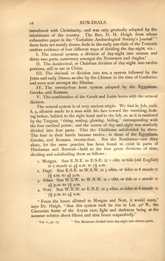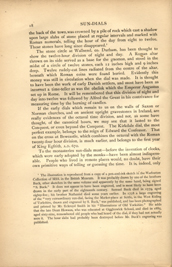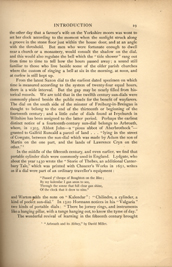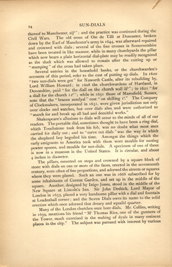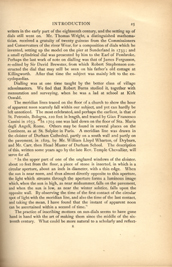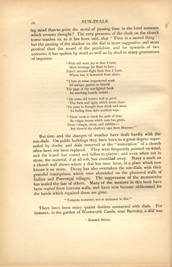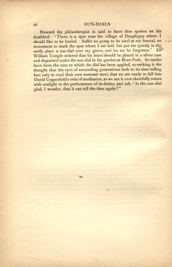SUN-DIALS
CHAPTER I
INTRODUCTION
|
"The Dial which doth houres direct— (Life's guider, Daye's divider, Sun's consorter, Shadow's dull shifter and Time's dumb Reporter.)" |
| SYLVESTER'S Du Bartas, Divine Weekes. |
THERE is no human invention more ancient, or more interesting, than that of the sun-dial; so ancient that the exquisite essayist, Charles Lamb, says, "Adam could scarce have missed it in Paradise"; and so interesting, that we may be sure that man's first want, after supplying the cravings of hunger, would be to invent some instrument by which he could measure the day-time into portions, to be allotted to his several vocations.
"Please, sir, what's o'clock?" is the child's enquiry, as he "tents" his mother's cow in the lane pastures; and the hardy backwoodsman, hewing out a settlement for himself in the primæval forest, leans on his axe, and looks to the sun's position in the heavens for information how soon he may retire to his hut for food and sleep. Time is a blank if we cannot mark the stages of its progress; and it has been found that the human mind is incapable of sustaining itself against the burden of solitary confinement in a dark room, where no note can be taken of time. The great Creator, Who made the sun to rule the day, and the moon and the stars to govern the night, has adapted our nature to these intermitting changes, and implanted in us an immediate desire to count how, drop by drop, or grain by grain, time and life are passing away.
Edgar Poe sings, in melancholy strain, as he stands in imagination on the seashore:
|
"I hold within my hand Grains of the golden sand; How few, yet how they creep Through my fingers to the deep. While I weep!" |
The first notion of dissecting time would, of course, be suggested by a tree, or a pole stuck in the soil, the shadow of which, moving from west to east, as the sun rose or declined in the sky, would lead men to indicate by strokes on the ground the gradual progression of the hours during which the daylight lasted. Further observation would discover that if the pole were slanted so as to point to the north star, and lie parallel with the earth's axis, a sun-dial would be constructed that would measure the day. But the fixing of a complete instrument, varying in its lines and numbers, according to the locality, whether horizontally or vertically placed, would be a matter of progressive astronomical and mathematical calculation, which only the scientific could accomplish, long after the rude art of uncivilized man had discovered the means of ascertaining midday, and dividing into spaces the morning and afternoon.
Herodotus (443 B.C.) says, "It was from the Babylonians that the Greeks learned concerning the pole, the gnomon, and the twelve parts of the day" (B. ii., cap. 109).1 These twelve parts, however, would always differ in length according to the season, except at the equinox, because the ancients always reckoned their day from sunrise to sunset. The word "hour," therefore, as they used it, must be regarded as an uncertain space of time, until it was accurately defined by astronomical investigation.
The Jewish Scriptures, our oldest literature, give us no clear information as to how time was reckoned in the ancient world. "The evening and the morning were the first day" (Gen. i. 5) is the earliest description of a period of time whose duration we cannot precisely
1 "The Greeks of later times had a double mode of reckoning the hours. According to the popular method, they divided the period from sunrise to sunset into twelve equal parts. The hours reckoned upon this principle varied in length with the season. According to the more scientific method, the day and night at the equinox were severally divided into twelve equal parts, and each of them was reckoned as an hour. The division of the day into twelve parts, which Herodotus describes... was doubtless reckoned according to the former method. Πόλος signified a hollow hemisphere; and hence came to signify the basin or bowl of a sun-dial in which the hour lines were marked. In this sense it is used by Herodotus." — Adapted from Sir G. C. Lewis, "Astronomy of the Ancients."
estimate. A week is also thus defined: "On the seventh day God ended His work which He had made, and He rested on the seventh day from all His work which He had made" (Gen. ii. 2).
Farther on in the Jewish history we find the day divided into four parts. In Nehemiah, ix. 3, we read: "They stood up in their place, and read in the book of the law of the Lord their God one fourth part of the day; and another fourth part they confessed, and worshipped the Lord their God." This mode of computation appears to have lasted until our Saviour's time; the householder in the parable, hiring servants, is described as going out at the third, sixth, and ninth hours to engage additional labourers, and afterwards at the eleventh hour before the day closed (Matt xx. 1-8). The night was not divided into hours, but into military watches; the Jews recognized three such divisions, the "beginning of the watches" (Lam. ii. 19), the "middle watch" (Judges, vii. 19), and the "morning watch" (Ex, xiv. 24; I Sam. xi. 11); "the second watch," or the "third watch" (Luke, xii. 37, 38). The Greeks and Romans had four of these night watches, and after the establishment of the Roman supremacy in Judæa it is evident that the division of the Jewish night was altered. In Acts, xii. 4, four relays of soldiers are spoken of; and in Matt xiv. the "fourth watch"; whilst in Mark, xiii. 35, the four watches are described as "even, midnight, cockcrowing, and morning."
The mention of the hour as a distinct space of time occurs first in the Book of Daniel;1 it is probable, therefore, that after the Captivity the Babylonian division of day and night into twelve parts was adopted by the Jews, and amalgamated with their own system. This was also the case with the Assyrians, amongst whom the calendar of their Accadian neighbours was in use as early as the reign of Tiglath Pileser I. "Along with the establishment of a settled calendar," writes Professor Sayce, ''came the settled division of day and night. The old rough division of the night into three watches, which we find in the Old Testament, remained long in use; but although the astrological works of Sargon's library do not know of any other reckoning of time, it was gradually superseded by a more accurate system."2
The Egyptians divided their day and night into twenty-four parts at a very early period.
But our business is with sun-dials, and the first on historical record is that of Ahaz, who reigned over Judah in the eighth century B.C. It has
1 Daniel, iii. 6; iv. 19.
2 "On the Astronomy and Astrology of the Babylonians," Professor A. H. Sayce; "Transactions of the Society of Biblical Archæology," vol. iii., 1874.
been observed that the Babylonians or Chaldæans were the first people who seem to have divided time by any mechanical contrivance. A lucid atmosphere is favourable to celestial contemplation, of which the people of the East have always availed themselves; and, even now, those countries most abound in sun-dials which have the clearest skies. The Rev. S. C. Malan thus writes of a visit to Ur of the Chaldees, and the landscape of serene beauty presented to him on the site of Rebekah's well: "As the shadows of the grass and of the low shrubs around the well lengthened and grew dim, and the sun sank below the horizon, the women left in small groups; the shepherds followed them, and I was left in this vast solitude, yet not alone; the bright evening star in the glowing sky to westward seemed to point to the promised land, as when Abraham took it for his guide."
From this people of Chaldæa, these star-searchers of the old world, we may conclude that Ahaz got his dial, and we read in the history of the unfortunate reign of this king a possible, nay, a likely, cause of his introduction of Babylonian customs. Being pressed in war by the kings of Israel and Syria, Ahaz sought alliance and rescue from Tiglath Pileser II., king of Assyria, who, indeed, relieved him in his emergency, but made him pay a heavy tribute, and conform his worship to that of the Assyrians. "The altars at the top of the upper chamber of Ahaz"1 which Josiah removed, were probably connected with the worship of the stars, and they prove the adoption of Babylonian usages. Among these we may imagine that the "dial of Ahaz"2 held a conspicuous place; but what its actual form was, remains a matter of conjecture.
The word "degrees" in our translation of the Bible has been, in the margin and in the Revised Version, rendered "steps," and this reading has given rise to various suppositions. Some writers have thought that a pillar outside the king's palace threw a shadow on the terrace walk, which indicated the time of day. The Rev. J. W. Bosanquet considers3 that "the invention of the pole and gnomon combined, producing an instrument perfect in itself for all observations, was probably connected with the rectification of the Babylonian calendar in B.C. 747, nineteen years before the accession of Ahaz," and that the dial was therefore a scientific instrument, the shadow being cast on steps in the open air, "or more probably within a closed chamber, in which a ray of light was admitted from above, which passed from winter to summer up and down an apparatus in the form of steps. Such chambers were in use in Eastern observatories till the middle of the eighteenth century."
1 2 Kings, xxiii. 12.
2 2 Kings, xx. 9-11.
3 "Transactions of the Society of Biblical Archæology," vol. iii., 1874.
On the other hand, one of the explanations which the Rabbins give of the dial of Ahaz is, that it was "a concave hemisphere, in the middle of which was a globe, the shadow of which fell upon diverse lines engraved on the concavity." They add that these lines were twenty-eight in number.1 This description is not unlike the dial attributed to Berosus.
It is remarkable that no sun-dials of the ancient Egyptians are known. Those which have been found associated with Egyptian monuments, such as the one discovered at the base of Cleopatra's Needle, are of Greek origin. Professor Rénouf, writing in 1887, says: "We are at a loss as to the method used by the Egyptians for measuring time. They certainly had some method, for we have copies of a very ancient calendar, giving the hours of the night at which certain stars culminated. Of course this could not have been a dial, and it must have been an instrument by which equal intervals of time were measured. It may have been an hour-glass or a water-clock, but no such instruments have been found. There is an Egyptian word signifying a clock, but the picture of the hieroglyph looks to me like a meridian instrument. There is no reason for supposing that the obelisks were intended for gnomons, though they might possibly have been utilized for the purpose. We know that at a later time they actually served as lightning conductors."
Whether obelisks or pillars were formerly used as time-tellers or not, a primitive mode of dividing time by similar means is still practised in Upper Egypt. The natives, we are told, plant a palm-rod in the open ground, and arrange a circle of stones round it, thus forming a sort of clock face, and on this the shadow of the palm falls, and marks the time of day. The plougher will leave his buffalo standing in the furrow to consult this rude horologe, and learn how soon he may cease from his work — illustrating the words of Job (vii. 2), "As a servant earnestly desireth the shadow."
Sun-dials of this sort, used for regulating the hours of work for a waterwheel, were noticed as recently as 1893 by Mr. E. A. Floyer. He writes that "two kinds were used. At Edfu a horizontal dhurra stalk lay north and south on two forked uprights. East and west were pegs in the ground, dividing evenly the sphere of earth between the sunrise and sunset shadows of the horizontal gnomon. Further south, the gnomon was a vertical stick. The gnomon and the space between the two pegs are equally called alka. To the question, 'What do you
1 Kitto's "Pictorial Bible," notes, vol. i.
do when the shadow reaches this peg?' the answer always comes, 'We harness, or hitch on, another pair of bullocks.' At Aswan, instead of a stick, a wall or boulder is sometimes used, and the dividing pegs are pressed in level with the soil, lest they should be removed by the feet of cattle or passers-by. The phrase may often be heard, 'Go and see the alka'; that is, 'Go and see the time.'... Some twenty years ago, in Arabia, the celebrated sheikh Daij of Koweit, wishing to test the astronomical knowledge of the writer, asked him to construct a sun-dial. He interrupted learned explanations about knowledge of latitude, horizontal planes, etc., by abruptly planting his spear in the ground and marking with his foot where the shadow would fall at the hour of prayer."1
A learned friend offers the following remarks: "The shadow of a tree or vertical pillar cannot permanently indicate the time of day, because its motion is not uniform. The sun's motion in his diurnal track is uniform; he always describes the same angle in the same time; but the angular velocity of the shadow of a tree or pillar is greater at noon than it is at sunrise or sunset; it also varies with the time of year. The gnomon that indicates the time of day must slope to the horizontal plane at an angle equal to the latitude of the place, and must also lie due north and south. This may be illustrated by the blunder the Romans made in bringing a Sicilian sun-dial to Rome."2 The same authority proceeds to say, "The proper slope of the gnomon may be obtained without a knowledge of the latitude; and the Babylonians probably did obtain this, and from it determined the latitude, and ascertained that the earth is spherical; so also the Greeks. A vertical gnomon may be used to determine, not the time of day, but its length and variation of length in terms of equinoctial hours, and thus the Egyptian obelisk brought to Rome by Augustus was used,3 though from causes which Pliny conjectures, the inferences they drew were subsequently found to be erroneous. During the Attic period, the Greeks of that city ascertained the time of day by measuring a shadow, but it is difficult to determine how they did this. They talk of a six-foot shadow or mark, a ten-foot shadow or mark, etc. Expressions of this kind are very frequent, and yet they give little or nothing whereby to show the particulars of the measurement — whether it was the length of the shadow that was measured, or its angular distance from a given line, or even what the thing was that gave the shadow." [In Aristophanes (Eccl. 652) is
1 "Primitive Sun-dials in Upper Egypt," Ath., 1895, ii. 458.
2 Pliny, H. N., vii. 214; Censorin, de D. N., 23.
3 Pliny, H. N., xxxvi. 72.
found the expression στοιχεĩον δεκάπουν , a gnomon 10 feet long, probably meaning "supper-time"; and in Greek writers of a later period the same word is used, with epithets signifying 6, 12, and 7 feet. There also occurs the word ἡ σκιὰ, the shadow, to which the same epithets are applied.] "There is little in any of these writers to suggest even a conjecture, still less to support a probable one, respecting the mode of measuring the shadow. The shadow was thrown on the ground; it was 20 feet long in the morning, about 6 at noon, and 10 or 12 in the afternoon. Salmasius conjectures that it was each man's own shadow, which he measured with his own foot. This is really ingenious, but all that is certain is, that the method was far from exact, very imperfect, and required altering several times in the year."
Such was the conclusion at which our learned friend arrived; but one more quotation must be given from his kindly comments: "There certainly is a considerable probability that what is called poetic astronomy is as old as human nature itself; and it is a very perfect system. Without any instrumental aid the first occupiers of Arabia could determine the time of year and the time of day with as much accuracy as they had any occasion for. The loss of this science, and the causes, moral and historical, that produced it, are curious, and as connected with the Holy Bible, they are important; but all these matters require leisure, long life, and patience, — things which few possess, and still fewer wish for."
Salmasius' conjecture that a man's shadow was measured by the foot, though probably the foot of another person, receives confirmation from a passage in Flacourt's travels in Madagascar. In the middle of the seventeenth century Flacourt found that the Malay population, having learned the divisions of the day from the Arabs, made use of the shadow of a man to tell the time, and measured by the length of the foot. In that latitude there is not much variation between the seasons. When the shadow was twenty-four times the length of the foot, they said that the sun was within an hour of rising or setting, as the case might be.1
Traces of the Semitic use of the gnomon have lately been found in Rhodesia. In a paper read before the Royal Geographical Society in February, 1899, Dr. H. Schlicter stated that amongst the ruins discovered at Zimbabye there was an enormous gnomon comprising a total angle of 120 degrees, which he thought might date from about 1000 B.C. The country was then colonized by Semitic races from the
1 Houzeau et Lancaster, "Bib. Mathematique," Introd, vol. i.
borders of the Red Sea, Jews, Phœnicians, and Western Arabians. Strabo1 speaks of countries "where a gnomon is placed perpendicularly on a plane surface; the shadow which it casts at midday falls first to one side and then to the other. This, however, only occurs in the tropics, with us the shadow always falls to the north."
Amongst the "Laws of the Buddhist Priesthood" there is one which directs that instruction shall be given to the candidate for the priesthood "respecting the measuring of the shadow, the several seasons, the divisions of the day, and concerning the uses of the whole of these."
When we turn to the known history of sun-dials the first name which meets us is that of Anaximander of Miletus. He placed gnomons in the Sciothera of Lacedæmon for the purpose of indicating the solstices and equinoxes, and is said to have introduced sun-dials into Greece about the year B.C. 560. Anaximander had studied under Thales, who was of a Phœnician family, and had travelled in Egypt, and an art which had reached Jerusalem in the days of Ahaz must equally have become known to the Phœnicians.
The Greek sun-dials do not seem to have told the hours of the day before the fourth century B.C. Till then, and after, the time was ascertained by clepsydræ, which, though dividing the day into equal periods, had this disadvantage, that they required to be constantly watched, and could not be carried about. But the great advance in scientific knowledge, due to the labours of astronomers and mathematicians, as Berosus the Chaldæan, Eudox of Cnidus, Aristarchus of Samos, Archimedes, Apollonios of Perga, Dionysidorus of Melos, and others, brought with it the invention of instruments which told the time more conveniently than the clepsydræ, and not less accurately. Meton the astronomer is said to have set up a sun-dial against the wall of the Pnyx at Athens in 433 B.C., and there was a similar dial at Achradina near Syracuse in the time of Archimedes, a copy of which was placed on the deck of the great ship of Hiero. In the third century B.C. the comic poet Baton speaks of a horologium or sun-dial as a means for determining the time of day. A specimen Greek sun-dial found at Heraclea, and now in the Louvre, is thought to date from the early part of the same century. As in Greek the numerals are represented by letters of the alphabet, it so happens that those letters which indicate the hours from noon to 4 p.m. also spell the word ζηθι = "live." An epigram attributed to Lucian plays upon this word in the lines:
1 Bk. II., pp. 125-136.
|
ἓξ
ὥραι
μόχθοις
ἰκανώταται,
αἱ
δὲ
μετ᾽
αὐτὰς γράμμασι δεικνύμεναι ΖΗΘΙ λέγουσι βροτοῖς. "Six hours to toil, the rest to leisure give; In them — so say the dialled letters — LIVE."1 |
The Romans adopted dials from the Greeks, and Papirius Cursor set up the first in Rome in the court of the Temple of Quirinus in 293 B.C. At this time the astronomical year of twelve months was introduced instead of the old Roman year of ten months; "and," writes Mr. Dyer,2 "perhaps with a sly innuendo on the part of its dedicator, this dial was placed in front of the Temple of Quirinus, or Romulus, who was reputed to have established the year of ten months." Before this time noon was proclaimed by a crier — the Consul's marshal — from the front of the Curia, when the sun appeared between the Rostra and a spot called "the station of the Greeks." About thirty years later, in 263 B.C., during the first Punic war, Valerius Messala, having taken the town of Catania in Sicily, brought a sun-dial from that place. This was set on a pillar near the Rostra, but not being calculated for the latitude of Rome, it told the time inaccurately enough. It remained, however, without a rival for ninety-nine years, until, in 164 B.C., Marcius Philippus, then Censor, put up a more carefully designed dial beside it. Another sun-dial was subsequently placed in the Forum, on the Basilica Æmilia, and was probably drawn upon a plane surface. That of Marcius Philippus seems to have been a concave spherical dial.
The obelisk which now stands in the Piazza Monte Citorio, Rome, was brought from Egypt by the Emperor Augustus, and set up as a gnomon in the Campus Martius, under the direction of the mathematician Facundus Novus. The pavement around it was marked out with lines in bronze, which were sunk as deeply in the ground as the height of the obelisk itself. The obelisk seems to have kept its place for some centuries, but was ultimately thrown down and lost sight of. It
1 Another epigram, throwing better light on the way to live, was composed by a later author, Philip Doddridge (1702-1751). He wrote it upon the motto of his family, "Dum vivimus vivamus":
"'Live while you live,' the epicure would say,
'And seize the pleasures of the passing day.'
'Live while you live,' the sacred preacher cries,
'And give to God each moment as it flies.'
Lord, in my views, let both united be;
I live in pleasure when I live to Thee."2 "City of Rome," Introd., p. lvi. See also Pliny, H. N., vii. 60.
was found, together with parts of the figures of the dial, in 1463, but again suffered neglect, and was not placed where it is now till 1792.1
That dials were frequently to be seen in ancient Rome is evident from the lines attributed to Plautus, who died about 184 B.C., and it is probable that the information they gave was noisily announced at stated intervals by a trumpeter or crier:
|
"The gods confound the man who first found out How to distinguish hours — confound him, too, Who in this place set up a sun-dial, To rub and hack my days so wretchedly Into small pieces ! When I was a boy, My belly was my sun-dial — one more sure, Truer, and more exact than any of them. The Dial told me when 'twas proper time To go to dinner, when I had aught to eat; But, now-a-days, why even when I have, I can't fall to, unless the sun gives leave. The town 's so full of these confounded dials, The greatest part of its inhabitants. Shrunk up with hunger, creep along the street." — Quoted by Aulus Gellius, B. 3, C. 3. |
Cicero, in the year B.C. 48, writes to Tiro about a sun-dial which he desired to put up at his villa at Tusculum; and his death is said to have been foretold by the omen of a raven striking off the gnomon of a dial.2
An epigram, attributed to the Emperor Trajan,3 refers to the art of dialling:
|
TPAIANOϒ BAΣIΛEΩΣ.
᾿Aντἰον
ἡέλιον
στέσας
ῥίνα
καὶ
στόμα
χάσκον, |
He was ridiculing a man who had a long nose and a wide mouth, very much curved, and grinning; while his many teeth, all visible, resembled the characters that denote the hours, and their double line.
There can be little doubt that the use of sun-dials extended over the greater part of the Roman Empire. From inscriptions which have
1 Pliny, H. N., xxxvi. 9, § 71, 72; "Astronomy of the Ancients," by Sir G. C. Lewis; "Encyc. Brit," 8th edit.; "Rome and the Campagna," by R. Burn.
2 "Epist. ad Fam.," xvi. 18; Lewis, "Astronomy of the Ancients"; Val. Max.i. 5, 5.
3 "Anthol. Pal.," xi. 418.
been preserved we may trace them in Italy, France, Germany, Spain, Dacia, and Algeria. Even a village such as the pagus Læbactium, now Castel Lavazzo, near Bclluno, possessed its horologium. Vitruvius enumerates thirteen different kinds of dials as known in his day, some of which were portable, and were to the larger dials what watches are to clocks. Plutarch, says M. Houzeau, mentions an equatorial tablet which was used in his time in Egypt. It was parallel with the plane of the equator, as was the style with the axis of the earth, and the equal hours were described on it. Most of the detached antique dials which remain to us appear to have been the work of Greek artists. The beautiful four-faced marble dial, brought from Athens by Lord Elgin, and now in the British Museum, bears the name of Phaidros, a Greek architect of the second or third century of the Christian era. This told the time of day to the passers-by in the streets of Athens, as did the eight vertical dials on the Tower of the Winds, which may be a little earlier in their date. A hemicycle, or hollowed dial, of the kind said to have been invented by Berosus, stood near the theatre of Dionysios; indeed neither Athens nor any other great city, had for some hundreds of years any lack of time-tellers. As for the Romans, they placed them, we are told,1 on their temples, their baths, their town houses, their country villas, in their public places, and on their tombs.
Dials were sometimes dedicated to the gods, notably to Jupiter,
Juno, and Diana, and, indeed, some of the gods were provided with
slaves whose special duty it was to tell them the time of day. For
"Peradventure he sleepeth, and must be awaked."
Baron de Rivière notices an inscription dating from about 47 B.C., and found at old Toulouse, which tells how a temple and horologium had been constructed by one Cirratus, and gives the names of the slaves who did the work. Dials were set on the tombs in order to draw attention to the epitaphs which recorded the name and virtues of the deceased. It was hoped the passers-by might read these when they paused to note the time.
After the fall of the Roman Empire the inscriptions cease, but we find other notices of sun-dials even in the "dark ages." Thus, in the sixth century, Theodoric, the great "Dietrich," sent a sun-dial and a clepsydra as presents to Gondebert, King of the Burgundians; and Cassiodorus, who himself gives us this piece of information, put up a dial on a monastery in Languedoc. In the time of Justin II., A.D. 565-
1 Marquardt, "Vie privée des Romains."
578, there was a sun-dial at Constantinople with an inscription quoted by Sir George Lewis:
|
ὡράων
σκοπίαζε
σοφὸν
σημάντορα
χαλκὸν αὐτῆς ἐκ μονάδος μέχρι δυωδεκάδος. "Watch the wise brazen index of the hours From very unity until the twelfth." |
Pope Sabianus, who succeeded Gregory the Great in A.D. 606, is said to have ordered dials and clocks (clepsydræ) to be placed on churches so as to distinguish the time of day. In the ninth century the Venerable Bede gave directions1 for the construction of sun-dials (e.g., "to make a dial of metal or wood with six sides, each with a gnomon"); and in the tenth century Gerbert, the monk of Auvergne, placed a horologium in Magdeburg for the Emperor Otho, "after observing through a tube the star which guides the seaman "
Gerbert, who was born and brought up at Aurillac (where a modern sun-dial records his name and fame), died in 1003, as Pope Sylvester II. In his treatise on Geometry directions for making a sun-dial may be found.2 He had been educated on "the Marches of Spain," which then included Barcelona, and appears to have studied mathematics through the works of the Arabs, the inheritors of Greek learning. The best known Arabian writer is probably one who lived after Gerbert's time, at the beginning of the thirteenth century, Abul Hasan, or Ali ibn' Ismael, whose works were translated into French by M. de Sedillot, and published in Paris in 1834. They contain rules for the construction of plane, conical, and also of cylindrical dials, concave and convex. One of the plane dials is shaped like a horseshoe, and intended to be placed horizontally. Abul Hasan is said to have been the first to develope, practically, the theory of equal hours; and the invention of clocks, which took place about the same period, brought this division of night and day at last into general use. We do not know whether there was a sun-dial in the observatory at Samarcand built by Ulugh Bey, a Tartar prince, who died in 1489; but there is no doubt that the interest taken in the study of gnomonics long lingered in the East, and this is probably the reason why sun-dials are still commonly to be found in Mohammedan countries.
As prayer is ordered to be observed five times in every twenty-
1 "Libellus de Mensura Horologio," Bede, Op. Colon., 1612, tom, ii., p. 392.
2 "Geometria Gerberti," caput xciv.: Alla Ratio meridianum describendi. The text is obscure, and the "Cod." has instead of the above title: De horologio per umbram inveniendo.
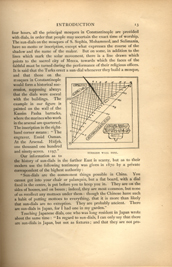
[Full Image]
TURKISH WALL DIAL.
four hours, all the principal mosques in Constantinople are provided with dials, in order that people may ascertain the exact time of worship. The sun-dials on the mosques of S. Sophia, Mohammed, and Sulimania, have no motto or inscription, except what expresses the course of the shadow and the name of the maker. But on some, in addition to the lines which mark the solar movement, there is a line drawn which points to the sacred city of Mecca, towards which the faces of the faithful must be turned during the performance of their religious offices. It is said that the Turks erect a sun-dial whenever they build a mosque, and that those on the mosques in Constantinople would form a historical succession, supposing always that the dials were coeval with the buildings. The example in our figure is painted on the wall of the Kassim Pasha barracks, where the marines who work in the arsenal are quartered. The inscription in the righthand comer means: "The engraver, Essüd Osman. At the Arsenal. Hidjrà, one thousand one hundred and ninety-seven. 1197."
Our information as to the history of sun-dials in the farther East is scanty, but as to their modern use the following testimony was given in 1870 by a private correspondent of the highest authority:
"Sun-dials are the commonest things possible in China. You cannot get into your chair or palanquin, but a flat board, with a dial fixed in the centre, is put before you to keep you in. They are on the sides of houses, and on boxes; indeed, they are most common, but none of us recollect any mottoes under them: though the Chinese have such a habit of putting mottoes to everything, that it is more than likely that sun-dials are no exception. They are probably ancient. There are sun-dials in Japan, for I had one in my garden."
Touching Japanese dials, one who was long resident in Japan wrote about the same time: "In regard to sun-dials, I can only say that there are sun-dials in Japan, but not as fixtures; and that they are not pro-
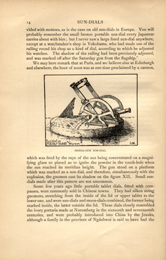
[Full Image]
SIGNAL-GUN SUN-DIAL.
vided with mottoes, as is the case on old sun-dials in Europe. You will probably remember the small bronze portable sun-dial every Japanese carries about with him; but I never saw a large fixed sun-dial anywhere, except at a watchmaker's shop in Yokohama, who had made use of the railing round his shop as a kind of dial, according to which he adjusted his watches. The shadow of the railing had been previously adjusted, and was marked off after the Saturday gun from the flagship."
We may here remark that at Paris, and we believe also at Edinburgh and elsewhere, the hour of noon was at one time proclaimed by a cannon, which was fired by the rays of the sun being concentrated on a magnifying glass so placed as to ignite the powder in the touch-hole when the sun reached its meridian height. The gun stood on a platform which was marked as a sun-dial, and therefore, simultaneously with the explosion, the gnomon cast its shadow on the figure XII. Small sun-dials made after this pattern are not uncommon.
Some few years ago little portable tablet dials, fitted with compasses, were commonly sold in Chinese towns. They had silken string gnomons, stretching from the inside of the lid or upper tablet to the lower one, and were sun-dials and moon-dials combined, the former being marked inside, the latter outside the lid. These dials closely resembled the ivory portaria made at Nuremberg in the sixteenth and seventeenth centuries, and were probably introduced into China by the Jesuits, although a family in the province of Ngáuhwni is said to have had the
monopoly of their manufacture "from remote antiquity."1 The Chinese are known to have been able to determine the obliquity of the ecliptic by means of the gnomon as early as B.C. 1100,2 but it is not certain when they became acquainted with the use of the pole. Possibly this discovery may have come to them, as to the Greeks, from Babylon. Their night and day, like that of the Chaldeans, is divided into twelve parts, and begins at what with us is 11 p.m. These spaces, which are marked by signs, are divided into eight kih, answering to our quarters of an hour. This system is of later date than Confucius, in whose time the ten-hour division was in use.
Passing from Asia to America, we meet with traces of sun-dials before the Spanish Conquest. Prescott3 tells us of the immense circular block of carved porphyry disinterred in 1790 in the great square of the city of Mexico, on which the calendar was engraved, and which is declared by Gama to have been a vertical sun-dial. The Peruvians also had erected pillars of curious and costly workmanship serving as dials, and from these they learned to determine the time of the equinox. When the shadow was scarcely visible under the noontide rays, they said that "the god sat with all his light" upon the column.4 Their Spanish conquerors threw down these pillars as savouring of idolatry.
We shall not expect to find amongst the northern nations that understanding of the art of dialling which the Arabs inherited from Greece. We have, however, some record of the manner in which our Teutonic forefathers measured time, in the dials which are here and there found built into the walls of old churches. These stones, roughly engraved with lines placed at varying intervals, and radiating from a common centre where once a gnomon was placed, were the time-tellers of Englishmen before the Conquest, and have been thought to show the manner in which the tribes by whom Britain was settled were wont to divide their day.
The Greek and Latin method of dividing night and day into twenty-four hours, which now prevails over Europe, made its way slowly in England. It is probable that it was not adopted by the invading tribes for a long time after their settlement in Britain. If the Britons, as is likely, learned it from the Romans, they kept their knowledge to themselves, and this time division must have been re-
1 Macgowan, "Timekeeping," "Chinese Repository," vol. xx.
2 "Trans. of Soc. of Biblical Archæology," vol. iii., pt. i.
3 Prescott, "Conquest of Mexico," 1850, vol. i., p. 103.
4 Ibid., "Conquest of Peru," vol. i., p. 110.
introduced with Christianity, and was only gradually adopted by the inhabitants of the country. The Rev. D. H. Haigh, from whose exhaustive paper in the "Yorkshire Archæological Society's Journal"1 these facts are mainly drawn, finds in the early sun-dials of the Teutonic settlers evidence of four different ways of dividing the day-night, viz.:
I. The octaval system, a division of day-night into sixteen and thirty-two parts, customary amongst the Norsemen and Angles.2
II. The duodecimal, or Chaldean division of day-night into twelve portions, still in use in China.
III. The decimal, or division into ten, a system followed by the Jutes and early Danes, as also by the Chinese in the time of Confucius, and even now amongst the Hindus.
IV. The twenty-four hour system adopted by the Egyptians, Greeks, and Romans.
V. The combination of the Greek and Latin hours with the octaval division.
The octaval system is of very ancient origin. We find in Job, xxiii. 8, 9, allusion made to a man with his face toward the sunrising, looking before, behind, to the right hand and to the left, or, as it is rendered by the Targum, "rising, setting, glowing, hiding," corresponding with the four cardinal points; and the course of day and night was similarly divided into four parts. This the Chaldeans subdivided by three. The four in their hands became twelve; in those of the Egyptians, Greeks, and Romans, twenty-four. But the Northmen — nor they alone, for the same practice has been found to exist in parts of Hindustan and Burmah — held to the four great divisions of time, dividing and subdividing them as follows:
1. Morgan. Sun E.N.E. to E.S.E. = 1 eikt, or tide (old English) = 2 stundr = 4 ½ a.m. to 7 ½ a.m.
2. Dagr. Sun E.S.E. to W.S.W. = 3 eikts, or tides = 6 stundr = 7 ½ a.m. to 4 ½ p.m.
3. Aftan. Sun W.S.W. to W.N.W. = 1 eikt, or tide = 2 stundr = 4 ½ p.m. to 7 ½ p.m.
4. Nott. Sun W.N.W. to E.N.E. = 3 eikts, or tides = 6 stundr = 7 ½ p.m. to 4 ½ a.m.
"From the hours allotted to Morgan and Nott, it would seem," says Dr. Haigh, "that this system took its rise in Lat. 42° N., the Caucasian home of the Aryan race, light and darkness being at the summer solstice about fifteen and nine hours respectively."
1 Vol. v., pt 17.
2 The Mexicans divided their day-night into sixteen parts.
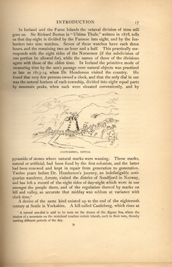
[Full Image]
CASTLEBERG, SETTLE.
In Iceland and the Faroe Islands the octaval division of time still goes on. Sir Richard Burton in "Ultima Thule," written in 1878, tells us that day-night is divided by the Faroese into eight, and by the Icelanders into nine watches. Seven of these watches have each three hours, and the remaining two an hour and a half. This practically corresponds with the eight tides of the Norsemen (if the subdivision of one portion be allowed for), while the names of three of the divisions agree with those of the olden time. In Iceland the primitive mode of measuring time by the sun's passage over natural objects was practised as late as 1813-14, when Dr. Henderson visited the country. He found that very few persons owned a clock, and that the only dial in use was the natural horizon of each township, divided into eight equal parts by mountain peaks, when such were situated conveniently, and by pyramids of stones where natural marks were wanting. These marks, natural or artificial, had been fixed by the first colonists, and the latter had been renewed and kept in repair from generation to generation. Twelve years before Dr. Henderson's journey, an indefatigable antiquarian wanderer, Arentz, visited the district of Sondfjord in Norway, and has left a record of the eight tides of day-night which were in use amongst the people there, and of the regulation thereof by marks on hill and valley, so accurate that midday was seldom at variance with clock time.1
A device of the same kind existed up to the end of the eighteenth century at Settle in Yorkshire. A hill called Castleberg, which rises at
1 A natural sun-dial is said to be seen on the shores of the Ægean Sea, where the shadow of a mountain on the mainland touches certain islands, each in their turn, thereby marking different periods of the day.
the back of the town,was crowned by a pile of rock which cast a shadow upon large slabs of stone placed at regular intervals and marked with Roman numerals, telling the hour of the day from eight to twelve. These stones have long since disappeared.1
The stone circle at Wallsend, co. Durham, has been thought to show the twelve-hour division of night and day. A Roman altar thrown on its side served as a base for the gnomon, and stood in the midst of a circle of twelve stones, each 12 inches high and 9 inches deep. Twelve rudely-cut lines radiated from the centre of the altar, beneath which Roman coins were found buried. Evidently this money was still in circulation when the dial was made. It is thought to have been the work of early Danish settlers, and must have been as incorrect a time-teller as was the obelisk which the Emperor Augustus set up in Rome. It will be remembered that this division of night and day into twelve was followed by Alfred the Great in his contrivance for measuring time by the burning of candles.
If the early dials which remain to us on the walls of Saxon or Norman churches, and on ancient upright gravestones in Ireland, are really evidences of the octaval time division, and not, as some have thought, of the canonical hours, we may see that it lasted to the Conquest, or even beyond the Conquest. The Kirkdale dial, the most perfect example, belongs to the reign of Edward the Confessor. That on the cross at Bewcastle, which combines the octaval with the Roman twenty-four hour division, is much earlier, and belongs to the first year of King Egfrith, A.D. 670.
To the monasteries sun-dials must — before the invention of clocks, which were early adopted by the monks — have been almost indispensable. People who lived in remote places would, no doubt, have their own primitive ways of telling or guessing the time. It is, indeed, only
1 The illustration is reproduced from a copy of a pen-and-ink sketch in the Warburton Collection of MSS. in the British Museum. It was probably drawn by one of the brothers Buck, other sketches in the same volume and apparently by the same hand, being signed "S. Buck." It does not appear to have been engraved, and is most likely to have been drawn in the early part of the eighteenth century. Samuel Buck died in 1779, aged eighty-five; his brother Nathaniel died some years earlier. In 1778 a large engraving of the "very extraordinary sun-dial, facing the Market-place at Settle, in the West Riding of Yorkshire, drawn and engraved by S. Buck," was published, and has been photographed and printed by Mr. Eckroyd Smith in his "Illustrations of Old Yorkshire." He adds that the late Dean Howson, who was educated at Giggleswick School, and died in 1885, aged sixty-nine, remembered old people who had heard of the dial, if they had not actually seen it. The hour slabs had probably been destroyed before Mr. Buck's engraving was published.
the other day that a farmer's wife on the Yorkshire moors was wont to set her clock according to the moment when the sunhght struck along a groove in the stone floor just within the house door, and at an angle with the threshold. But men who were fortunate enough to dwell near a church or a monastery, would consult the shadow on the dial, and this would also regulate the bell which the "tide shower" rang out from time to time to tell how the hours passed away; a sound still familiar to those who live beside some of the older parish churches where the custom of ringing a bell at six in the morning, at noon, and at curfew is still kept up.
From the latest Saxon dial to the earliest dated specimen on which time is measured according to the system of twenty-four equal hours, there is a wide interval. But the gap may be nearly filled from historical records. We are told that in the twelfth century sun-dials were commonly placed beside the public roads for the benefit of wayfarers. The dial on the south side of the minster of Freiburg-in-Breisgau is thought to belong to the end of the thirteenth or beginning of the fourteenth century; and a little cube of dials found at Ivychurch in Wiltshire has been assigned to the latter period. Perhaps the earliest distinct notice of a fourteenth-century sun-dial belongs to Arbroath, where, in 1303, Abbot John — a "pious abbot of Aberbrothock" — granted to Galfrid Runcald a parcel of land... "lying in the street of Cowgate, between the sun-dial which was made by Adam the son of Martin on the one part, and the lands of Lawrence Cryn on the other."1
In the middle of the fifteenth century, and even earlier, we find that portable cylinder dials were commonly used in England. Lydgate, who about the year 1430 wrote the "Storie of Thebes, an additional Canterbury Tale," which was printed with Chaucer's Works in 1651, writes as if a dial were part of an ordinary traveller's equipment:
| "Passed ye thrope of Boughton on the Blee; By my kalendar I gan anon to see, Through the sonne that full clear gan shine, Of the clock that it drew to nine." |
and Warton adds the note on "Kalendar": "Chilindre, a cylinder, a kind of pocket sun-dial." In 1520 Hormann notices in his "Vulgaria" two kinds of portable dials: "There be jorney rings, and instruments like a hanging pillar, with a tunge hanging out, to know the tyme of day."
The wonderful revival of learning in the fifteenth century brought
1 "Arbroath and its Abbey," by David Miller.
Greek and Arabian science within the compass of European knowledge. Equal hours were then in general use, and the study of gnomonics was resumed. The mathematician Purbachius, or George of Peurbach, a Bavarian, who died in 1462 at a comparatively early age, gave great attention to this branch of learning, as did his better known pupil, Regiomontanus (so called from his birthplace, Königsberg in Bavaria, but otherwise known as Johann Müller), who was considered to be the greatest astronomer and mathematician of his time. Regiomontanus set up a printing press at Nuremberg, and also made astronomical instruments, with the help of a worthy and studious citizen, Bernard Walther, and it was no doubt owing to these two men that the making of sun-dials became one of the special industries of Nuremberg. Regiomontanus died in 1476 in Rome, where he had gone to assist Pope Sixtus IV. to reform the Calendar, but for a century or more Nuremberg continued to be the home of a succession of scientific men.
Scultetus (Bartholomew Schulz), in the dedicatory epistle prefixed to his "Gnomonice de Solaris" (1572), gives a sketch of the history of gnomonics, and says that Regiomontanus was followed by Stabius, an Austrian, and Andreas Stiborius, a Bavarian and professor at Vienna, who invented new forms of dials, and gave directions for making spherical, concave, columnar, pyramidal, ring dials, and others. The works of these two writers have never been printed, but those of others named by Scultetus may still be met with, as the four books of "De Solaribus Horologiis" by Orontius Finæus (Oronce Finé), the works of Sebastian Münster, Peter Apian (mathematician to Charles V. and professor at Ingoldstadt), Gemma Frisius, Georgius Hartmann, Andreas Schöner of Nuremberg, and Johannes Hommelius of Meiningen, who died in 1562, a hundred years after Purbachius. "By these and others the science of gnomonics had," says Scultetus, "in the course of a century, been brought to a great perfection."
In fact, we find that in the sixteenth century the erection of sun-dials went on fast. In Scotland one was placed on the newly-founded King's College in Aberdeen soon after the year 1500. In England we have recorded in the book of disbursements of Sir Thomas Lucas, solicitor-general to Henry VII., that he paid xxd for "a dial set on my bruge," at Little Saxham in Suffolk in 1505; and in France the church of Rouelles, Normandy, still shows a two-faced dial of the same period, with the hours marked in Arabic numerals, underneath a beautiful projecting window. But the presence of a German mathematician at Oxford in the reign of Henry VIII. had probably the most important
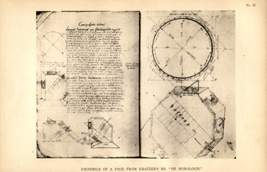
[Full Image]
FACSIMILE OF A PAGE FROM KRATZER'S MS. "DE HOROLOGIS"
influence in our own country, for to him can be traced one of the earliest of those detached or monumental dials which afterwards took such curious and beautiful forms, especially in Scotland, and were worked out with all sorts of ingenious arrangements of lines and hollows.
It was in the year 1517 that Nicholas Kratzer, or Kratcher, a Bavarian, was admitted at the age of thirty to the new college of Corpus Christi at Oxford, founded by Bishop Fox. His name is on the list of lecturers appointed by Cardinal Wolsey, and he lectured on astronomy and mathematics. Tunstall, writing in 1520, calls Kratzer the "deviser of the King's horologies." He became a fellow of Corpus, and while at Oxford he constructed two sun-dials, one for St. Mary's Church, which stood on the churchyard wall till 1744, and another for the college garden. In a MS. work, "De Horologiis," now in the college library, Kratzer says that many of the directions for making dials were taken from an old book in the Carthusian monastery at Auerbach, near Vienna. Kratzer was a man of a merry spirit, and much beloved. When Henry VIII., asked him how it was that after so many years in England he had not learned to speak the language, he is said to have replied frankly: "Pardon, your highness, but how can a man learn English in only thirty years?"
A portrait of Kratzer standing surrounded by mathematical instruments, and holding a polyhedron in his hand, one of Holbein's finest works (see frontispiece), is now in the Louvre. Holbein himself was a lover of dials. He has introduced them into his picture of "The Two Ambassadors," possibly with some reference to special times and dates; and into his illustration to the Old Testament in the history of Hezekiah. He also designed an elaborate timekeeper, a clock, clepsydra, and sun-dial combined, for Sir Anthony Denny to present to Henry VIII. as a New Year's gift.
Albert Dürer also made use of the dial in his designs, and, like Holbein, not idly, but with symbolic meaning. In the engraving of the "Melancholia," a dial is on the wall above the hour-glass and near to the bell which tolls the passing day. Dürer may also be counted amongst the writers on dialling, from his reference to the subject in his book on geometry, printed in 1532.
A Spanish painter of the same century, Martin Galindez, also turned his mind to the same pursuits, and constructed sun-dials for the Carthusian convent of Paular, where he died as a monk in 1627. When Mr. Ford travelled in Spain (1830-40), the sun-dial made by Torriano for the Emperor Charles V., and under his supervision, was still standing in the Emperor's private garden at the convent of Yuste.
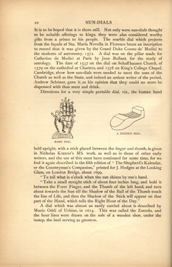
[Full Image]
HAND DIAL. A ZOCCOLO DIAL.
It is to be hoped that it is there still. Not only were sun-dials thought to be suitable offerings to kings, they were also considered worthy gifts from a prince to his people. The marble dial which projects from the façade of Sta. Maria Novella in Florence bears an inscription to record that it was given by the Grand Duke Cosmo de' Medici to the students of astronomy, 1572. A dial was on the pillar made for Catherine de Medici at Paris by Jean Bullant, for the study of astrology. The date of 1537 on the dial on Schaffhausen Church, of 1579 on the cathedral at Chartres, and 1578 on Kings College Chapel, Cambridge, show how sun-dials were needed to meet the uses of the Church as well as the State, and indeed an ardent writer of the period, Andrew Schöner, gave it as his opinion that they could no more be dispensed with than meat and drink.
Directions for a very simple portable dial, viz., the human hand held upright, with a stick placed between the finger and thumb, is given in Nicholas Kratzer's MS. work, as well as in those of other early writers, and the use of this must have continued for some time, for we find it again described in the fifth edition of "The Shepherd's Kalendar, or the Countryman's Companion," printed for J. Hodges at the Looking Glass, on London Bridge, about 1699.
"To tell what is o'clock when the sun shines by one's hand.
"Take a small streight stick of about four inches long, and hold it between the Forer Finger, and the Thumb of the left hand, and turn about towards the Sun till the Shadow of the Ball of the Thumb touch the line of Life, and then the Shadow of the Stick will appear on that part of the Hand, which tells the Right Hour of the Day."
A dial which was almost as easily carried about is described by Muzio Oddi of Urbino, in 1614. This was called the Zoccolo, and the hour lines were drawn on the sole of a wooden shoe, under the instep, the heel serving as gnomon.
The first English work treating solely of Dialling was published in 1593, and was to a great extent a translation from Witikendus. It appears as a small black-letter quarto, entitled "Horologiographica, the Art of Dialling, teaching an easie and perfect way to make all sorts of dials on any plane pat, howsoever placed, with the drawing of the twelve signes, and houres unequall in them all. At London, Printed by Thomas Orwin, dwelling in Paternoster Row over against the Sign of the Checker." The author, Thomas Fale, writes in his preface that "many have promised (but none as yet performed) to write of this science in our English tongue which hath been published in other languages, as D. Recorde long since, M. Digges, M. Blagrave, with others, who if they would take the paines, I know could doe it with great commendation."
Mr. Blagrave, who had already touched on the subject in his "Mathematical Jewell," seems to have responded to this appeal, for in 1609 he brought out a book on the Art of Dialling. The Latin work of the mathematician Clavius, which had appeared in 1581, is said to have exhausted the subject, but he was followed by many writers, both English and foreign, up to the middle of the eighteenth century. So highly esteemed were the dials set up in the King's Privy Garden at Whitehall, that in 1624 Mr. Edmund Gunter, Professor of Astronomy at Gresham College, wrote a full description of them by the special direction "of the Prince his Highness," and dedicated it to James I. The interest of Charles I. in the subject never flagged. He constantly carried about with him a small silver mathematical ring, a dial, of a construction invented by M. Delamain, which he much valued, and the night before his execution he gave it to his attendant Herbert, in charge for the Duke of York. Probably to his fine taste the beautiful dial at Holyrood House, called Queen Mary's, is due. It was made in 1638, the year in which the King visited Scotland and was crowned in Edinburgh. He is said to have presented it to Queen Henrietta Maria.
The Scottish dials of the seventeenth century form a unique and remarkable series, delightful alike to the artist, the architect, and the mathematician. They were designed with a view to the adornment of the house and garden, as well as for general use and the fancy of the curious.
About the same period, or a little later, people began to make use of the shafts of destroyed crosses, in churchyards and market-places, as supports for sun-dials. The destruction of the crosses was going on in Queen Elizabeth's reign, as is shown by the following entry in the parish books of Prestbury, Lancashire: "1577. Item: for cuttynge the cross in the churchyard, and for charge of one with a certificate
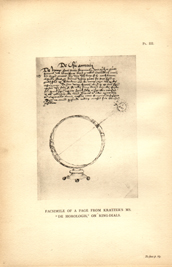
[Full Image]
FACSIMILE OF A PAGE FROM KRATZER'S MS. "DE HOROLOGIS," ON RING-DIALS.
To face page 23.
thereof to Manchester, xijs"; and the practice was continued during the Civil Wars. The old cross of Ote de Tilli at Doncaster, broken down by the Earl of Manchester's army in 1644, was afterward repaired and crowned with dials; several of the fine crosses in Somersetshire have been treated in like manner, while in many churchyards the pillar which now bears a plain horizontal dial-plate may be readily recognized as the shaft which was allowed to remain after the cutting up or "stumping" of the cross had taken place.
Several entries in the household books, or the churchwarden's accounts of this period, refer to the cost of putting up dials. In 1620 "two sun-dials were got" for Naworth Castle, after its rebuilding by, Lord William Howard; in 1608 the churchwardens of Hartland, in Devonshire, paid "for the diall on the church wall iiis"; in 1621 "for a diall for the church 12s"; while in 1651 those of Maresfield, Sussex, note that the "brazen sundyal" cost "on shilling is." The Company of Clockmakers, incorporated in 1631, were given jurisdiction not only over clocks and watches, but over dials also, and were authorized to "search for and break up all bad and deceitful works."
Shakespeare's allusions to dials will occur to the minds of all of our readers. The portable dial, sometimes thought to have been a ring dial, which Touchstone took from his fob, was no doubt what most men carried for daily use; and to "carve out dials "was the way in which the shepherd boy beguiled his time. Amongst the things which the early emigrants to America took with them were moulds for casting pewter spoons, and moulds for sun-dials. A specimen of one of these is now in a museum in the United States. It is circular, and about 4 inches in diameter.
The pillars, mounted on steps and crowned by a square block of stone with dials on one or more of the faces, erected in the seventeenth century, were often of fine proportions, and adorned the streets or squares where they were placed. Such an one was in 1668 subscribed for by some inhabitants of Covent Garden, and set up in the middle of the square. Another, designed by Inigo Jones, stood in the middle of the New Square at Lincoln's Inn. Sir John Dethick, Lord Mayor of London in 1655, placed a very handsome pillar with a dial and fountain at Leadenhall corner; and the Seven Dials owes its name to the solid erection which once adorned that dreary and squalid quarter.
Many of the London churches once bore dials. Mr. Collins, writing in 1659, mentions his friend "Mr Thomas Rice, one of the gunners of the Tower, much exercised in the making of dyals in many eminent places in the city." The subject was pursued with interest by various
writers in the early part of the eighteenth century, and the getting up of dials still went on. Mr. Thomas Wright, a distinguished mathematician, received a gratuity of twenty guineas from the Commissioners and Conservators of the river Wear, for a composition of dials which he invented, setting up the model on the pier at Sunderland in 1733; and a small cylindrical dial was presented by him to the Earl of Pembroke. Perhaps the last work of note on dialling was that of James Fergusson, re-edited by Sir David Brewster, from which Robert Stephenson constructed the dial that may still be seen on his father's old cottage at Killingworth. After that time the subject was mainly left to the encyclopædias.
Dialling was at one time taught by the better class of village schoolmasters. We find that Robert Burns studied it, together with mensuration and surveying, when he was a lad at school at Kirk Oswald.
The meridian lines traced on the floor of a church to show the hour of apparent noon scarcely fall within our subject, and yet can hardly be left unnoticed. The most celebrated, and perhaps the earliest, is that of St. Petronio, Bologna, 220 feet in length, and traced by Gian Francesco Cassini in 1653. In 1703 one was laid down on the floor of Sta. Maria degli Angeli, Rome. Others may be found in several places on the Continent, as at St. Sulpice in Paris. A meridian line was drawn in the cloister of Durham Cathedral, partly on a south wall and partly on the pavement, in 1829, by Mr. William Lloyd Wharton, of Dryburn, and Mr. Carr, then Head Master of Durham School. The description of this, written some years ago by the late Rev. Temple Chevallier, will serve for all.
"In the upper part of one of the unglazed windows of the cloister, about 10 feet from the floor, a piece of stone is inserted, in which is a circular aperture, about an inch in diameter, with a thin edge. When the sun is near noon, and thus almost directly opposite to this aperture, the light which streams through the aperture forms a luminous image which, when the sun is high, as near midsummer, falls on the pavement, and when the sun is low, as near the winter solstice, falls upon the opposite wall. By observing the time of the first contact of the circular spot of light with the meridian line, and also the time of the last contact, and taking the mean, I have found that the instant of apparent noon can be ascertained within a second of time."
The practice of inscribing mottoes on sun-dials seems to have gone hand in hand with the art of making them since the middle of the sixteenth century. What could be more natural to a scholarly and reflect-
ing mind than to point the moral of passing time in the brief sentence which arouses thought? The very presence of the clock on the church tower teaches us, as it has been said, that "Time is a sacred thing": but the passing of the shadow on the dial is more suggestive and more poetical than the sound of the pendulum, and for upwards of two centuries it has spoken by word as well as by deed to many generations of inquirers.
|
"With still more joy to thee I turn, Meet horologe for Bard to love; Time's sweetest flight from thee I learn, Whose lore is borrowed from above. "I love in some sequestered nook Of antique garden to behold The page of thy sun-lighted book Its touching homily unfold; "On some old terrace wall to greet Thy form and sight, which never cloys. Tis more to thought than drink and meat, To feeling than Art's costliest toys. "These seem to track the path of time By vulgar means which man has given. Thou — simple, silent, and sublime — But show'st thy shadowy sign from Heaven!"1 |
But time and the changes of weather have dealt hardly with the sun-dials. On public buildings they have been to a great degree superseded by clocks, and dials removed at the "restoration" of a church often have not been replaced. They were frequently painted on wood, and the board has rotted and fallen to pieces; and even when cut in stone, the material, if at all soft, has crumbled away. Many a mark on a church wall shows where a dial has once been, in a place which now knows it no more. Decay has also overtaken the sun-dials, with their graceful inscriptions, which once abounded on the plastered walls of Italian and Provençal villages. The suppression of the monasteries has sealed the fate of others. Many of the mottoes in this book have been copied from convent walls, and have now become obliterated, for the hands which repaired them are gone.
"Tempora mutantur, nos et mutamur in illis!"
There have been many quaint devices connected with dials. For instance, in the garden of Wentworth Castle, near Barnsley, a dial was
1 Bernard Barton
formed of box edgings cut into the proper numerals, whilst a clipped yew tree in the centre acted as the gnomon. A similar dial is shown in Loggan's "Views of Cambridge" as in the gardens of Peterhouse College in 1675. Floral dials have also been invented, being composed of flowers that bloomed in succession during the hours of sunshine. These, however, are conceits which hardly come within the compass of our subject.
As clocks were erected in the church towers, or showed their faces in market-places, the vocation of the learned dialler gradually ceased. The old dial may still retain its footing in the quaint yew-treed garden, or may stand conspicuously in the churchyard, but few consult it as an oracle, and it rather lingers superfluously amongst us as a memento of the past. It has, nevertheless, to many minds a touching interest; it has drawn forth maxims in the form of mottoes, and it would be like discarding wisdom were we not to preserve and cherish them.
|
"But if these dials tell us after all We are but shadows on life's sunny wall, They not less point us with a hope as bright To that good land above where all is light."1 |
In spite, however, of the decay and destruction of older examples, the day of the sun-dial is not yet done. Many new ones have been set up within the last few years. Horizontal dials, with their graceful pedestals, are still erected in gardens, and vertical ones on country houses, and occasionally on a school or public building. The making of portable dials at Birmingham, and their exportation, still goes on,2 and Messrs. Barker of Clerkenwell Road inform us that a self-adjusting dial, which packs into small compass and can be fixed to suit any latitude, is made expressly for the use of explorers and travellers, and that one of this kind was carried by Dr. Livingstone through Africa. At the Horological Exhibition held at Berlin in 1899 Professor Reuleaux showed an equatorial dial of his own construction, which was said to mark every five minutes of time, and a dial which gives mean time is now exhibited in the Victoria and Albert Museum. It was invented by Major-General Oliver, R.A., but is not the first of its kind, as the Gottingen Museum has a mean-time dial of more ancient date. Both in France and Germany plain and easy works on dialling have been published within the last half century.
1 "Lines on a Collection of Sundial Mottoes," by H. V. Tebbs.
2 Ring dials are still used by the country folk in the Italian Tyrol. The writer bought one at Primiero in 1888.
Howard the philanthropist is said to have thus spoken on his deathbed: "There is a spot near the village of Dauphigny where I should like to be buried. Suffer no pomp to be used at my funeral, no monument to mark the spot where I am laid, but put me quietly in the earth, place a sun-dial over my grave, and let me be forgotten." Sir William Temple ordered that his heart should be placed in a silver case and deposited under the sun-dial in his garden at Moor Park. So tender have been the uses to which the dial has been applied, so striking is the thought that the eyes of succeeding generations look to its time-telling face only to read their own memento mori, that we are ready to fall into David Copperfield's vein of meditation, as we see it ever cheerfully return with sunlight to the performance of its duties, and ask, "Is the sun-dial glad, I wonder, that it can tell the time again?"
